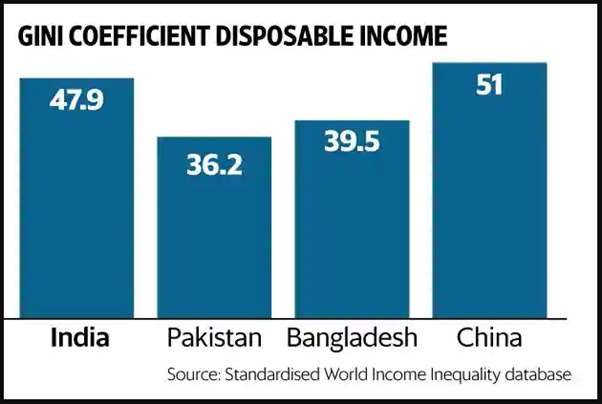A Banger from Bangladesh
Hey reader 🙌 , Today we are featuring an article by Mayank, an engineering undergrad who happens to be an ardent follower of finance and economics. You can find him readings articles, or writing one..
Isn't it funny how the most elementary ideas can be delved in to discover a plethora of complex extrapolations? Engineer Explains is all about simplifying complex concepts and ideas for a layman while discovering novelties throughout the process.
Click this button 👇 to find us from the comfort of your inbox! 📧
2020, ah the year of doom for the whole world especially for India. The highest recent rise in Covid-19 cases? 23.9% decrease in quarterly GDP? you might be wondering what more possibly can go worse than this. Well adding to the woes, IMF predictions show India is set to drop below Bangladesh in terms of per capita gross domestic product (GDP) this year, owing to the nationwide lockdown imposed to contain the spread of the COVID-19 pandemic.

According to IMF-World Economic Outlook (WEO), Bangladesh’s per capita GDP in dollar terms is expected to grow 4% in 2020 to $1,888. On the other hand, India’s per capita GDP is expected to decline by 10.5% to $1,877 – the lowest in the last four years. The GDP figure for both countries is at current prices.
Is it shocking? Considering a couple of years ago India had a lead of 25% in the same, yes it is. But more important questions to be asked are whether the trend remains? What does this infer? And most importantly, What will be the future of both countries? For answers, stay tuned and read the whole article.
How did this happen
RECENT FALTER IN GROWTH RATE
The economic slump in recent years with decreasing successive low GDP growth rates post 2016 is a major reason in closing out the gap. Meanwhile, Bangladesh has kept itself afloat with a constant GDP growth rate above 7 %

The above graph shows India’s GDP Growth Rate for the years 2009-2020
HIGHER POPULATION GROWTH
Secondly, over the same 15-year period, India’s population grew faster (around 21%) than Bangladesh’s population (just under 18%).
COVID-19 EFFECT
Lastly, the most immediate factor was the relative impact of Covid-19 on the two economies in 2020. While India’s GDP is set to reduce by 10% due to successive lockdowns and most non-essential services closed until now, Bangladesh’s is expected to grow by almost 4%. In other words, while India is one of the worst affected economies due to an extreme decrease in domestic market demand, Bangladesh is one of the bright spots due to the RMG (Ready-made garments) industry still not much affected due to constant sales on online platforms.
What does this infer?
Looking at the economic factors, an inference of India being economically superior to Bangladesh in the past can be made. Looking at the predicted growth rates India will regain back its position of having the second-highest GDP per capita in South Asia after Sri Lanka due to a sudden surge in demand due to end in lockdown having an advantage of a huge domestic market. But throwing light onto the fact economic indicators solely do not predict a country’s development and progress. The social indicators are needed to be taken into consideration as well when taken into consideration for both countries. A very interesting story comes out.
Not the first time?
Even after Bangladesh being economically weaker than India and being a labour extensive market. To our surprise, Bangladesh Performs better in several social indicators than India.
Having a life expectancy of 78.5 while India still struggling at 68.8 years.
Having an extremely less open defection rate of 1% achieved back in 2015 while India being at 34% still.
Faring much better in Gender parity at the 50th rank in the latest Gender Parity Index compared to 112th of India due to female participation in it’s biggest industry, garment production.
Doing better than their bigger neighbour in the fight against hunger, coming at 75th position in the latest Global Hunger Index whereas, India securing the 94th position
Lower infant mortality rate than India
Considering that Bangladesh is economically weaker than India shows the former’s tremendous efforts for inclusive growth. This means that Despite having economic capabilities, India is seeing an increase in inequality in the following years showing good economic indicators yet failing in the social ones. The below chart comparing the Average Gini coefficients of India and its neighbors for the past 5 years confirms the same

All is lost?
On the contrary. The predictions themselves can be incorrect at times and India has a chance to prove these predictions wrong. Despite the predictions, India has an extremely diversified economy with a strong service sector which expects high growth in 2021 combined with a huge agrarian economy with varied crop production. Bangladesh’s economy is extremely dependent on the RMG sector, which itself has taken a hit due to decreased worldwide demand with remittances sent and export of only jute as a raw material. Economically India will be able to regain back it’s lost position over Bangladesh in a year or two but, this incident is an extremely rude mirror to India conveying an urgency to work on the falling economy and to focus much more intensively on inclusive growth for all the sections of the country
But, for a fact, we can state that Bangladesh isn’t the poor, dependent neighbor it was in the 1970s after its separation from Pakistanaided by successful initiatives such as Gramin Bank for microfinance and the inclusion of a high number in the workforce. Bangladesh has set up its own identity in recent years. This in true sense is a Banger from Bangladesh



